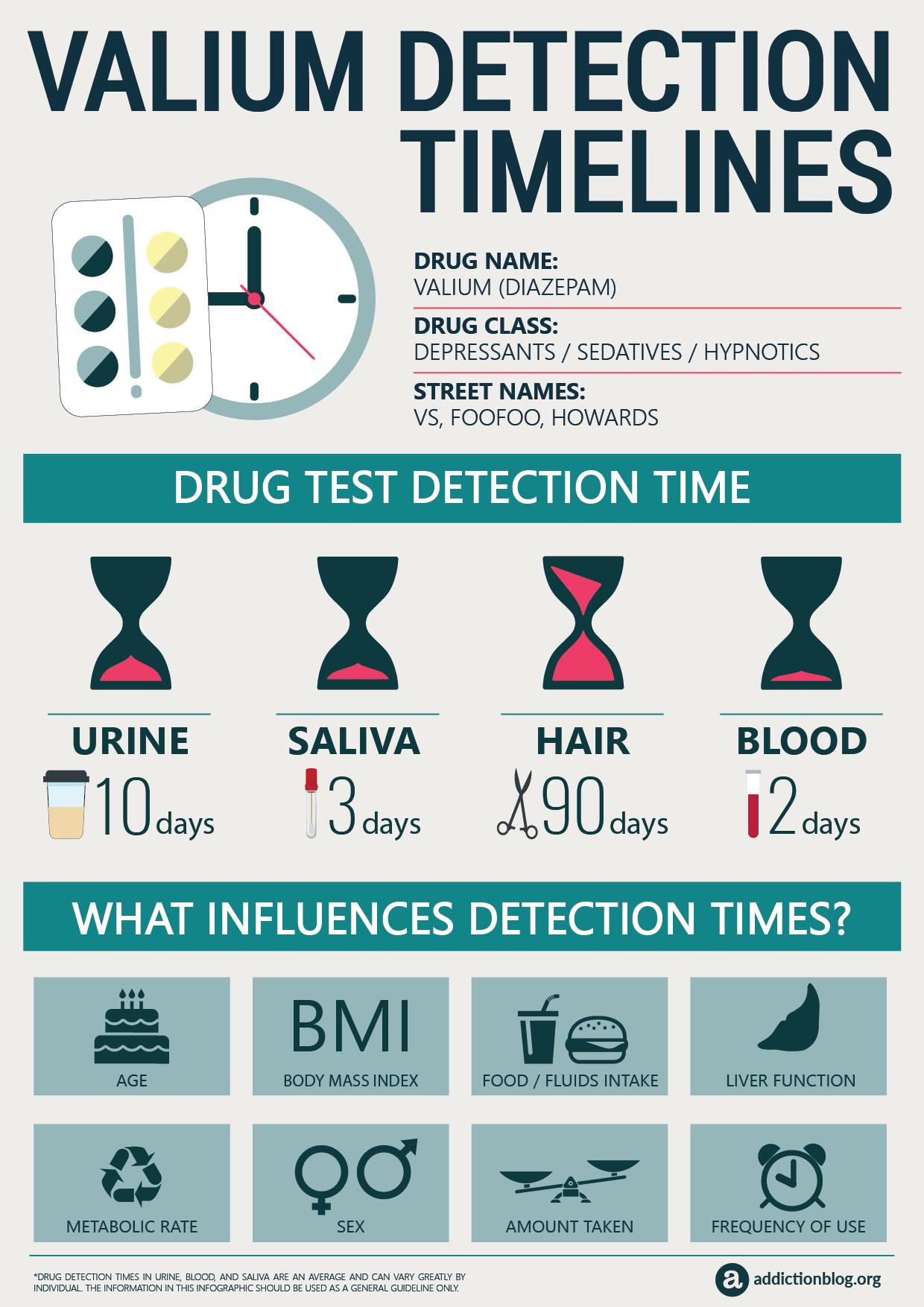ARTICLE OVERVIEW: If you are expecting a drug test for Valium, the brand name for diazepam, check out this infographic. We review detection times for Valium in urine, blood, hair and saliva. Plus, factors that influence it.
TABLE OF CONTENTS:

Drug Basics
Drug Name: Valium, main ingredient diazepam
Drug Class: Depressants/Sedatives/Hypnotics
Street Names: VS, FooFoo, Howards
Valium, generic name diazepam, is a benzodiazepine with central nervous system depressant effects. It is a long-acting prescription medication used to treat anxiety disorders, muscle spasms, seizures, insomnia, and alcohol withdrawal symptoms. It is available as tablets, oral solution and injection. [1]
Continued use of Valium for a period of longer than 4-6 weeks can easily lead to tolerance, dependence, and possible addiction. This is why the medication is listed as a Schedule IV under the Controlled Substance Act. [2]
Use Statistics
According to the 2017 National Survey on Drug Use and Health, there were more than 7 million Americans using diazepam in the past year. Of them, most were adults. Still, around 131,000 people who use Valium in the U.S. were adolescents and 650,000 were Americans between the ages 18-25.
More than 6 million U.S. adults reported using Valium in 2017.
Valium is also abused by more than a million Americans. That’s an estimated 0.4% of the U.S. population aged 12 or older. Nearly 50K teens, more than 200,000 young adults and nearly 800,000 adults aged 26+ reported past year abuse. [3]
Why Drug Test?
Diazepam is a tranquilizer that can cause sleepiness, drowsiness, confusion, and memory loss. Employers may order a drug test in order to identify the reasons for work impairment. In other cases, a court may order a drug test for legal reasons.
Additionally, there may be medical reasons for a drug text. For example, emergency rooms drug test in cases of injury or overdose. Or, your prescribing doctor may ask you for drug testing as part of your treatment. Finally, people in rehab are regularly tested for the presence of psychoactive drugs like diazepam. Knowing more about drug testing and how long Valium will remain in your system and is important, whatever the reasons.
Detection Window
A drug detection window is the period of time during which a drug screen can detect the presence of a drug or its metabolites in your urine, hair, saliva, or blood. The half-life of Valium is fairly long. On average, it can take 20 hours or even more for just half of the medication to be eliminated from your system. For chronic Valium users, diazepam can be detected in urine for 4-6 weeks even after you stop taking it.
However, drug detection windows are variable. We might even say that drug detection windows vary by person. This is because detection and metabolism depends on several individual factors, including the type of test used. Additionally, some people metabolize drugs relatively faster than other people.
There are several drug tests used to detect the presence of Valium in the body. These tests use different markers to detect the presence of diazepam in body fluids such as urine, saliva, hair, and blood.
Urine: A urine drug test will detect diazepam for up to 10 days after the last use.
Saliva: Valium is detectable on oral fluid tests 3 days after quitting.
Blood: The detection period for a blood tests is about 2 days.
Hair: Valium can be detected up to 90 days in hair follicle drug test.
IMORTANT: Diazepam detection times in urine, blood, hair, and saliva are in average and can vary greatly between individuals. You should use this information as a general guide only.
Influence Factors
There are many factors can factors that can affect the test’s results. Some of them include:
- Age
- Diet and use of fluids
- Frequency and length of use
- Gender
- Level of physical activity you engage in
- Liver and kidney function
- Metabolism
- Weight
- Your health
In general, younger people eliminate diazepam faster than older ones. In fact, Valium’s typical half-life in a young, healthy person is about 24 hours. Also, people with slower metabolism will have Valium longer in their system. Those with liver or kidney problems can also have slower the elimination period.
Any Questions?
If you have any other questions about Valium detection times, feel free to post them in the comment section below. We will gladly try to answer to all real life questions promptly and personally.
Moreover, if you feel that your Valium use is out of control and you need help quitting, you should consider addiction treatment. Don’t hesitate to call our caring admission navigators on the hotline number listed on this page. We are available 24/7 to discuss treatment options with you.








Related Posts